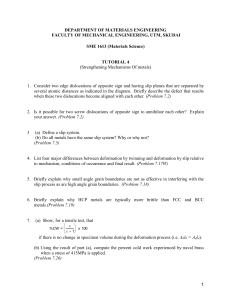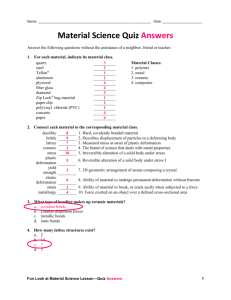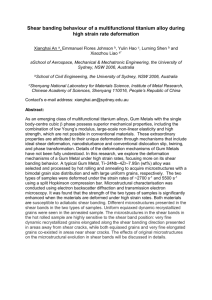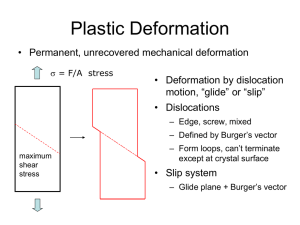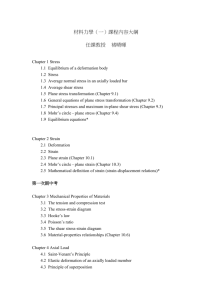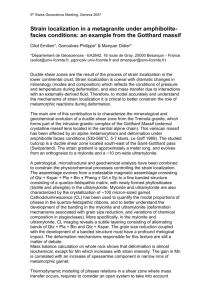Mechanical Properties of Metals 6.1 Elastic and Plastic Deformation
advertisement
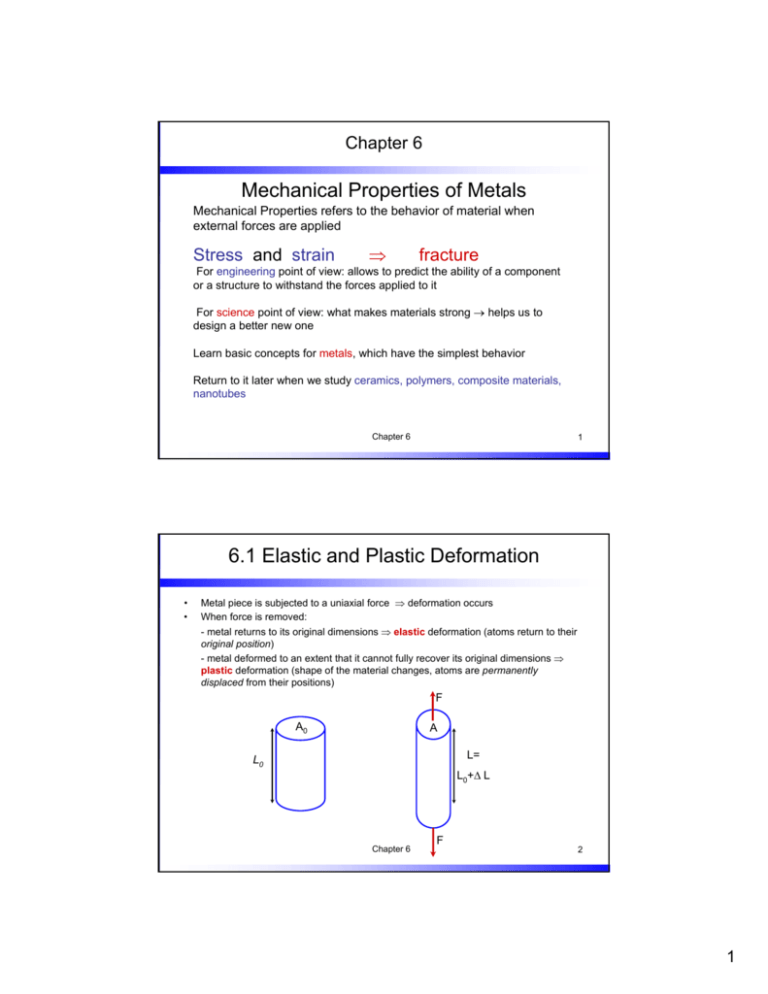
Chapter 6 Mechanical Properties of Metals Mechanical Properties refers to the behavior of material when external forces are applied Stress and strain ⇒ fracture For engineering point of view: allows to predict the ability of a component or a structure to withstand the forces applied to it For science point of view: what makes materials strong → helps us to design a better new one Learn basic concepts for metals, which have the simplest behavior Return to it later when we study ceramics, polymers, composite materials, nanotubes Chapter 6 1 6.1 Elastic and Plastic Deformation • • Metal piece is subjected to a uniaxial force ⇒ deformation occurs When force is removed: - metal returns to its original dimensions ⇒ elastic deformation (atoms return to their original position) - metal deformed to an extent that it cannot fully recover its original dimensions ⇒ plastic deformation (shape of the material changes, atoms are permanently displaced from their positions) F A0 A L= L0 L0+∆ L Chapter 6 F 2 1 6.2 Concept of Stress and Strain Load can be applied to the material by applying axial forces: Not deformed Tension Compression F A0 F A L0 A L= L= L0+∆ L L0+∆ L F F ∆L can be measured as a function of the applied force; area A0 changes in response Chapter 6 3 Stress (σ) and Strain (ε) Stress (σ) • defining F is not enough ( F and A can vary) Block of metal • Stress σ stays constant F A σ= F • Units A L= L0+∆ L Force / area = N / m2 = Pa usually in MPa or GPa Strain (ε) – result of stress F • For tension and compression: change in length of a sample divided by the original length of sample ε= ∆L L Chapter 6 4 2 Shear and Torsion (similar to shear) Not deformed Pure shear Torsion S A0 A0 L0 L0 S Θ L0 S S • Note: the forces are applied in this way, so that there is no net torque • If the forces are applied along the faces of the material, they are called shear forces Chapter 6 5 Shear Stress and Shear Strain If the shear force S acts over an area A, the shear stress τ: τ ( shear _ stress ) = S ( shear _ force) A(area ) The shear strain γ is defined in terms of the amount of the shear displacement a divided by distance over which the shear acts: γ= Chapter 6 a = tan Θ h 6 3 Elastic Properties of Materials • • Most materials will get narrow when stretched and thicken when compressed This behaviour is qualified by Poisson’s ratio, which is defined as the ratio of lateral and axial strain Poisson' s _ Ratio :ν = − εy εx =− εz εz • the minus sign is there because usually if εz > 0, and εx + εy < 0 ⇒ ν > 0 • It can be proven that we must have ν ≤ ½; ν = ½ is the case when there is no volume change (l x + ∆l x )(l y + ∆l y )(l z + ∆l z ) = l x × l y × l z Chapter 6 7 Poisson’s Ratio, ν • For isotropic materials (i.e. material composed of many randomly - oriented grains) ν = 0.25 • For most metals: 0.25 < ν < 0.35 • If ν = 0 :means that the width of the material doesn’t change when it is stretched or compressed • Can be: ν<0 (i.e. the material gets thicker when stretched) Chapter 6 8 4 6.3 Modulus of elasticity, or Young’s Modulus • Stress and strain are properties that don’t depend on the dimensions of the material (for small ε), just type of the material E= σ ( stress ) ε ( strain) • E – Young’s Modulus, Pa • Comes from the linear range in the stress-strain diagram • many exceptions… Behavior is related to atomic bonding between the atoms Material Young’s Modulus [GPa] Metals 20-100 Polypropelene 1.5-2 Rubber 0.01 Hydrogels and live cells <0.00001 Chapter 6 9 Q.: A wagon of mass m = 1100kg is suspended from the bridge by a steel cable of d = 1cm and length L = 10m. E(steel) = 2×1011Pa (a) By how much will the cable stretch? (b) Can the cable handle this? Chapter 6 10 5 Tensile Test 1. 2. 3. 4. 5. Modulus of elasticity Yield strength at 0.2% offset Ultimate tensile strength Percent elongation at fracture Percent reduction in area at fracture Chapter 6 11 Other tensile test characteristics: • Yield strength (at 0.2% offset) • Ultimate Tensile Strength (UTS): the maximum strength reached in the stressstrain curve σ= • • F ∆L = E× A(original ) L Percent elongation at fracture (measure of ductility of the metal) Percent reduction in area at fracture % _ reduction _ in _ area = Chapter 6 Ainitial − A final Ainitial × 100% 12 6 True and Engineering Stress σ engineering = F Ainitial σ true = = E× ∆L L F Ainstant Chapter 6 13 6.4 Hardness Hardness: a measure of the resistance of a material to plastic (permanent) deformation Measured by indentation • indenter material (ball, pyramid, cone) is harder than the material being tested (i.e.: tungsten carbide, diamond) • indenter is pressed at 90o • hardness is based on the depth of the impression or its crosssectional area Several common hardness tests: hardness numbers can be calculated Material strength and hardness are related Hardness test is nondestructive ⇒ often used Chapter 6 14 7 Hardness tests: hardness numbers Chapter 6 15 6.5 Plastic deformations of single crystal metals A rod of a single crystal Zn (hcp) stressed beyond its elastic limit: • slipbands: slip of metal atoms on specific crystallographic planes (slip planes) • slip is predominately along the basal planes A rod of a single crystal Cu (fcc) during plastic deformation: • slip lines: 50-500 atoms apart • slipbands: separated by ~>10,000 atomic planes Chapter 6 16 8 Other mechanical characteristics • Ductility: amount of plastic deformation that occurs before fracture - if ductility is high, the material can be deformed by applying stresses. Ex.: gold - if it is low, material breaks first, without significant deformation (material is brittle) - depend on T: at low T many metals become brittle and can break as a glass • Resilience: ability to have high yield strength and low E. Ex.: good springs • Toughness: ability to absorb energy up to a fracture Chapter 6 17 Mechanism of Slip deformation the group of atoms do NOT slide over each other during plastic shear deformation ⇒ the process requires too much energy The process takes less energy!!! Chapter 6 18 9 Motion of Dislocations In the metal slip mechanism, dislocations move through the metal crystals like wave fronts, allowing metallic atoms to slide over each other under low shear stress ⇒ deformation without fracture Chapter 6 19 Slip Systems Typically slip planes are the most densely packed planes (less energy is required to move from one position to another), which are the farthest separated Combination of a slip plane and a slip direction: slip system Chapter 6 20 10 Slip systems observed in crystal structures For hcp crystals: 3 slip systems, restricts their ductility Chapter 6 21 Schmid’s Law Slip process begins within the crystal when the shear stress on the slip plane in slip direction reaches critical resolved shear stress τc hcp (Zn, Mg): 0.18, 0.77 MPa fcc (Cu): 0.48 MPa τr = Fr Aslip _ plane Fr = F cos λ τr = Aslip _ plane = Ao cos φ F cos λ cos φ F = cos λ cos φ = σ cos λ cos φ Schmid’s law Ao Ao Chapter 6 22 11 Q.: A stress of 75 MPa is applied in the [0 01] direction on an fcc single crystal. Calculate (a) the resolved shear stress acting on the (111) [-101] slip system and, (b) (b) the resolved shear stress acting on the (111) [-110] slip system. Chapter 6 23 Mechanical Twinning Another important plastic deformation mechanism (low T) Schematic diagram of surfaces of a deformed metal after (a) slip and (b) twinning from G. Gottstein Chapter 6 24 12 6.6 Plastic Deformations in Polycrystalline Metals • • • • Majority of engineering alloys and metals are polycrystalline Grain boundaries – act as diffusion barriers for dislocation movements In practice: fine grain materials are stronger and harder (but less resistant to creep and corrosion) Strength and grain size are related by Hall-Pelch equation: σ y = σo + k d σo and k – constants as grain diameter decreases, the yield strength of the material increases Chapter 6 25 Pile-up of dislocations Schematic Observed in stainless steel (TEM) Grain shape changes with plastic deformation Dislocation arrangement changes Chapter 6 26 13 6.7 Cold Plastic Deformation for Strengthening of Metals • • The dislocation density increases with increased cold deformation New dislocations are created by the deformation and must interact with those already existing • As the dislocation density increases with deformation, it becomes more and more difficult for the dislocations to move through the existing dislocations ⇒ Thus the metal work or strain hardens with cold deformation Percent cold work versus tensile strength and elongation for unalloyed oxygen-free copper Cold work is expressed as a percent reduction in cross-sectional area of the metal being reduced. Chapter 6 27 6.8 Superplasticity in Metals Superplasticity: the ability of some metals to deform plastically by 1000-2000% at high temperature and low loading rates Ex.: Ti alloy (6Al – 4V) 12% @ RT, typical tensile test load rates ~1000% @ 840oC, lower loading rates Requirements: 1. The material must possess very fine grain size (5-10mm) and be highly strain-rate density 2. A high loading T (>0.5 Tm) is required 3. A low and controlled strain rate in the range of 0.01-0.00001 s-1 is required Chapter 6 28 14 Nanocrystalline Metals • Nanocrystalline metals: d < 10-50nm σ y = σo + • k d Consider Cu: σo = 25 MPa, k = 0.11 MPa m0.5 (from Table 6.5) 25MPa + 0.11MPa σ 10 nm 10 −8 = ? = σ 10 µm 25MPa + 0.11MPa −5 10 Is this possible? Different dislocation mechanism: grain boundary sliding, diffusion, etc Chapter 6 29 Summary •Introduced stress, strain and modulus of elasticity σ= F A ε= ∆L L E= σ ( stress ) ε ( strain) • Plastic deformations of single crystal metals - In the single crystal metal - slip mechanism: dislocations move through the metal crystals like wave fronts, allowing metallic atoms to slide over each other under low shear stress - Slip process begins within the crystal when the shear stress on the slip plane in slip direction reaches critical resolved shear stress τc - Schmid’s law: τr = F cos λ cos φ F = cos λ cos φ = σ cos λ cos φ Ao Ao • Plastic deformations in polycrystalline metals - Strength and grain size are related by Hall-Pelch equation: σ y = σo + k d • Nanocrystalline materials Chapter 6 30 15
